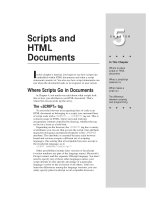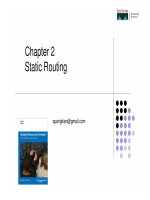Routing Protocols and Concepts: Chapter 5 doc
Bạn đang xem bản rút gọn của tài liệu. Xem và tải ngay bản đầy đủ của tài liệu tại đây (663.72 KB, 81 trang )
Chapter 5
RIP version 1
Routing Protocols and Concepts
2
Topics
RIPv1: Distance Vector, Classful
Routing Protocol
Background and Perspective
RIPv1 Characteristics and
Message Format
RIP Operation
Basic RIPv1 Configuration
RIPv1 Scenario A
Enable RIP: router rip
Command
Specifying Networks
Verification and Troubleshooting
Verifying RIP: show ip route
Verifying RIP: show ip
protocols
Verifying RIP: debug ip rip
Passive Interfaces
Automatic Summarization
Modified Topology B
Boundary Routers and
Automatic Summarization
Processing RIP Updates
Sending RIP Updates
Advantages and
Disadvantages of Automatic
Summarization
Default Route and RIPv1
Modified Topology C
Propagating the Default Route
in RIPv1
RIPv1: A Distance Vector,
Classful Routing Protocol
Background and Perspective
RIPv1 Characteristics and Message Format
RIP Operation
4
RIPv1: Distance Vector, Classful Routing Protocol
The first protocol used was Routing Information Protocol (RIP).
RIP still popular: simple and widespread support.
Why learn RIP?
Still in use today.
Help understand fundamental concepts and comparisons of
protocols
such as classful (RIPv1) and classless (RIPv2)
5
Background and Perspective
RIP is not a protocol “on the way out.”
In fact, an IPv6 form of RIP called RIPng (next generation) is now
available
6
Background and
Perspective
Charles Hedrick wrote RFC 1058 in 1988, in which he documented
the existing protocol and specified some improvements.
RFC 1058 can be found at />7
RIPv1 Characteristics and Message Format
Note:
The first version of RIP is often called RIPv1 to distinguish it from
RIP version 2 (RIPv2).
However, both versions share many of the same features. When
discussing features common to both versions, we will refer to
RIP. When discussing features unique to each version, we will
use RIPv1 and RIPv2.
RIPv2 is discussed in Chapter 7.
RIP characteristics:
Distance vector routing protocol.
Metric: hop count
Advertised routes with hop counts greater than 15 are
considered unreachable.
Response messages (routing table updates) are broadcast every
30 seconds. (RIPv2 uses multicasts)
8
RIPv1 Characteristics and Message Format
Next slide
9
RIPv1 Characteristics and Message Format
10
RIP Message Format: Route Entry
Each Route Entry (three fields):
Address Family Identifier (set to 2 for IP unless a router is requesting
a full routing table, in which case the field is set to 0)
IP Address: Network address of an advertised route
Metric: How many hops to get to this network via this router
(incremented by each router)
One RIP update can contain up to 25 route entries.
11
RIP Operation
Startup
1. Each RIP-configured interface sends out a Request message
Asking for their complete routing tables.
2. A Response message is sent back by RIP-enabled neighbors.
If new route: Installs in routing table.
If existing route: Replace if better hop count.
Startup router then sends a triggered update out all RIP-enabled interfaces
containing its own routing table so that RIP neighbors can be informed of
any new routes.
12
IP Address Classes and Classful Routing
RIPv1:
Classful routing protocol.
Does not send subnet mask in update.
A router either uses the subnet mask: (discussed later)
configured on a local interface or
applies the default classful subnet mask
Because of this limitation, RIPv1 networks cannot be discontiguous, nor can
they implement VLSM.
No subnet
mask
13
Administrative Distance
RIP has a default administrative distance of 120.
When compared to other interior gateway protocols, RIP is the least-
preferred routing protocol.
Note: This is irrelevant because you usually do not run multiple routing
protocols in the same domain, and even if you did you can modify these
AD values.
R3# show ip route
<output omitted>
R 192.168.1.0/24 [120/1] via 192.168.6.2, 00:00:05, Serial0/0/0
<output omitted>
R3# show ip protocols
<output omitted>
Routing Protocol is “rip”
Routing Information Sources:
Gateway Distance Last Update
192.168.6.2 120 00:00:10
Distance: (default is 120)
Basic RIPv1 Configuration
RIPv1 Scenario A
Enable RIP: router rip Command
Specifying Networks
15
Notice that this topology uses five Class C network addresses.
Remember, RIPv1 is a classful routing protocol
We will see that the class of the network is used by RIPv1 to determine the
subnet mask.
RIPv1 Scenario A
16
Enabling RIP: router rip Command
Enter router configuration mode for RIP, enter router rip at the
global configuration prompt.
Notice that the prompt changes.
R1# conf t
Enter configuration commands, one per line. End with CNTL/Z.
R1(config)# router ?
bgp Border Gateway Protocol (BGP)
egp Exterior Gateway Protocol (EGP)
eigrp Enhanced Interior Gateway Routing Protocol (EIGRP)
igrp Interior Gateway Routing Protocol (IGRP)
isis ISO IS-IS
iso-igrp IGRP for OSI networks
mobile Mobile routes
odr On Demand stub Routes
ospf Open Shortest Path First (OSPF)
rip Routing Information Protocol (RIP)
R1(config)# router rip
R1(config-router)#
17
Enabling RIP: router rip Command
router rip
Does not directly start the RIP process.
Provides access to configure routing protocol settings.
No routing updates are sent until additional commands are
configured.
no router rip
To remove the RIP routing process from a device
Stops the RIP process
Erases all existing RIP configuration commands.
R1# conf t
R1(config)# router rip
R1(config-router)#
18
Specifying Networks
To enable RIP routing for a network, use the network command in
router configuration mode
Enter the classful network address for each directly connected
network.
Router(config-router)# network directly-connected-classful-
network-address
19
Specifying Networks
The network command performs the following functions:
Enables RIP on all interfaces that belong to a specific network.
Associated interfaces will now both send and receive RIP
updates.
Advertises the specified network in RIP routing updates sent to
other routers every 30 seconds.
Router(config-router)# network
directly-connected-classful-
network-address
20
Specifying Networks
If you enter a subnet or host IP address, IOS automatically converts
it to a classful network address.
For example, if you enter the command network 192.168.1.32,
the router will convert it to network 192.168.1.0.
R1(config)# router rip
R1(config-router)# network 192.168.1.0
R1(config-router)# network 192.168.2.0
R2(config)# router rip
R2(config-router)# network 192.168.2.0
R2(config-router)# network 192.168.3.0
R2(config-router)# network 192.168.4.0
R3(config)# router rip
R3(config-router)# network 192.168.4.0
R3(config-router)# network 192.168.5.0
Only directly connected classful network
addresses!
21
Only directly connected classful network
addresses!
Verification and
Troubleshooting
Verifying RIP: show ip route
Verifying RIP: show ip protocols
Verifying RIP: debug ip rip
Passive Interfaces
23
Verifying RIP: show ip route Command
R1# show ip route
Codes: C - connected, S - static, I - IGRP, R - RIP, M - mobile,
<output omitted>
Gateway of last resort is not set
R 192.168.4.0/24 [120/1] via 192.168.2.2, 00:00:02, Serial0/0/0
R 192.168.5.0/24 [120/2] via 192.168.2.2, 00:00:02, Serial0/0/0
C 192.168.1.0/24 is directly connected, FastEthernet0/0
C 192.168.2.0/24 is directly connected, Serial0/0/0
R 192.168.3.0/24 [120/1] via 192.168.2.2, 00:00:02, Serial0/0/0
An R in the output indicates RIP routes.
Because this command displays the entire routing table, including
directly connected and static routes, it is normally the first command
used to check for convergence.
Routes might not immediately appear when you execute the
command because networks take some time to converge
24
Verifying RIP: show ip route Command
R2# show ip route
Codes: C - connected, S - static, I - IGRP, R - RIP, M - mobile,
<output omitted>
Gateway of last resort is not set
C 192.168.4.0/24 is directly connected, Serial0/0/1
R 192.168.5.0/24 [120/1] via 192.168.4.1, 00:00:12, Serial0/0/1
R 192.168.1.0/24 [120/1] via 192.168.2.1, 00:00:24, Serial0/0/0
C 192.168.2.0/24 is directly connected, Serial0/0/0
C 192.168.3.0/24 is directly connected, FastEthernet0/0
25
Verifying RIP: show ip route Command
R3# show ip route
Codes: C - connected, S - static, I - IGRP, R - RIP, M - mobile,
<output omitted>
Gateway of last resort is not set
C 192.168.4.0/24 is directly connected, Serial0/0/1
C 192.168.5.0/24 is directly connected, FastEthernet0/0
R 192.168.1.0/24 [120/2] via 192.168.4.2, 00:00:08, Serial0/0/1
R 192.168.2.0/24 [120/1] via 192.168.4.2, 00:00:08, Serial0/0/1
R 192.168.3.0/24 [120/1] via 192.168.4.2, 00:00:08, Serial0/0/1









